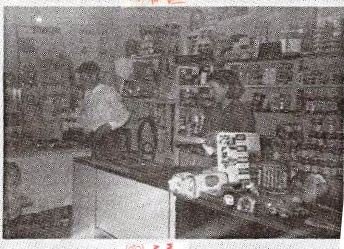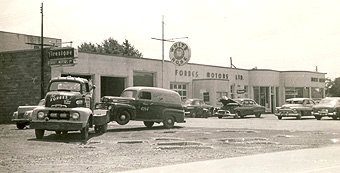

 Wikipedia Sitemap |
|
|  Useful Links 1 Useful Links 2 |
In Welland, we stopped looking for a place of our own. Here there was a bungalow-type house with a built-on, one-car garage and a small store with B.A. gas pumps in front of the establishment, for sale. It was not something to boast about, but for us, it was like a little kingdom, a place of our own in the new world, with a queen and a little prince. The price tag for our kingdom was $14,000.00, but we figured we could handle it. With around six thousand dollars of our own, and the rest from the bank, we were in business.
I did not have any illusions that now we had it made. Times would still be tough, we had to eat and feed the kid, the mortgage had to be paid off. By that time, the house and store, which were just sitting on top of the ground, would probably need to be rebuilt. Now I could display my mechanic's licence and legally repair autos.
We sold British American gas and oil and Dominion tires. In the store, we sold pop, milk from Mayor Pietz's dairy: "Sunnyside", ice cream from Neilson, groceries from two different wholesalers, etc. Anyway, we sold, as they say, everything from soup to nuts. We even had some chinaware, shoe laces, an electric shaver and the daily Welland Tribune.
The previous owner, John Owens, apparently had a licence but not a good name as a mechanic. After he sold out to us, he started a new place on Thorold Road, advertised he had moved and was open for business.
Maybe not a nice thing to do on his part, but it never hurt us. Coca Cola painted and supplied us with a new sign, which read, "CARL'S AUTO SERVICE." We started selling a little gas, maybe 300 gallons a week. B.A. wanted to sell more and more, so the salesman suggested I should put a sign at the road reading, "If you can't STOP, smile as you go by." I painted this and put it up. If it did sell more gas, we would never know. Gasoline sold then in 1954 for about 33 cents per gallon, which was about 4.5 litres. Not much profit for us, but we had the store with aspirin, ice cream and pop.
Also, I got a few customers to change oil and a get a grease job. Then I did a few tune ups, and slowly more and more customers came. I tried to do a good dependable job and was sure not to overcharge. Word got around, I suppose, and before the first year was over, the one-car garage was not sufficient any more. For instance, when I was working on a car and an oil change or grease job came in, I had to do it outside on the ground, (not a very nice situation for a king). So we decided to build a new garage big enough to hold at least two cars, plus room for a work bench, a wood stove for heating and a little storage.
I engaged one of my customers, a carpenter, to draw the blue prints and build the overhead doors. Another fellow dug the footing by hand, after his shift at a plant and on Saturday. And we got old Jack Smith, a jack of all trades, to lay the blocks. I also thought a pit would come in very handy to work on the bottom side of cars. So I borrowed a dirt bucket, which was a good size scoop with two handles, hitched an old Model A in front and dug the pit by scraping a little at a time until it was deep enough. Then Mr. Jansen, a neighbor and customer, built the forms for it. I also put a steel beam over the pit area to hoist engines and whatever needed to be raised later on. When this was all finished, I did everything from engines to transmissions and rear ends.
Business was expanding, I was getting calls to tow cars in, but how you gonna tow vehicles, I did not even have a mule. Pretty soon, though, I found a Model A 1.5 ton truck with dual wheels and 600 x 20 tires, but nothing else. Now to raise a vehicle, one needed a hoisting device, I purchased a one or two hundred year old stump puller which farmers used in the long gone years to clear the land, long before the invention of tractors or steam engines. This was built like an overgrown saw horse, with the required gears and a drum with a steel cable to exert tremendous pulling power, executed through a hand operated crank. Now all I needed was a boom to stick out with a pulley and a hook. To manufacture this, I wrecked another old truck, took the frame rails, shaped, bolted, hammered and cut, and by golly, we produced a fine tow truck. Yes, a fine piece of machinery, as Bud Roberts would say.
In the beginning, we worked pretty near seven days a week, only taking off time on Sundays to go to church. But when finances improved and I hired a helper, we slowed down to only a six-day work week.
The tow truck, of course, was available 24 hrs a day, seven days a week. This vehicle was slow, but very powerful. The gearing was so low I could spin the wheels on pavement. If that was not enough, the winch could drag anything out of the deepest ditch. Yes, even able to help George Emerson, who had a nasty habit of getting drunk everyday after work. He drove a big old Oldsmobile with coil springs in the rear, but no shocks. Most every night he stopped in at the store to call his wife to let her know, he was on his way home, about half a mile. But before he got out of the Olds, he sat there for a while until the car stopped rocking, which he seemingly liked very much, because he was not willing to put shocks on.
One time, I got a call from the police, to get George's car from the rail road tracks. It seemed when he got to the tracks on Riverside Drive, where Prince Charles ran parallel, he figured he was on the road and turned right. This, however, was a bit too soon. For a while he must have had the ride of a life time, bouncing over the ties. When he finally realized his mistake he turned toward the highway and promptly got stuck in the ditch, where the police found him.
Related resources:

